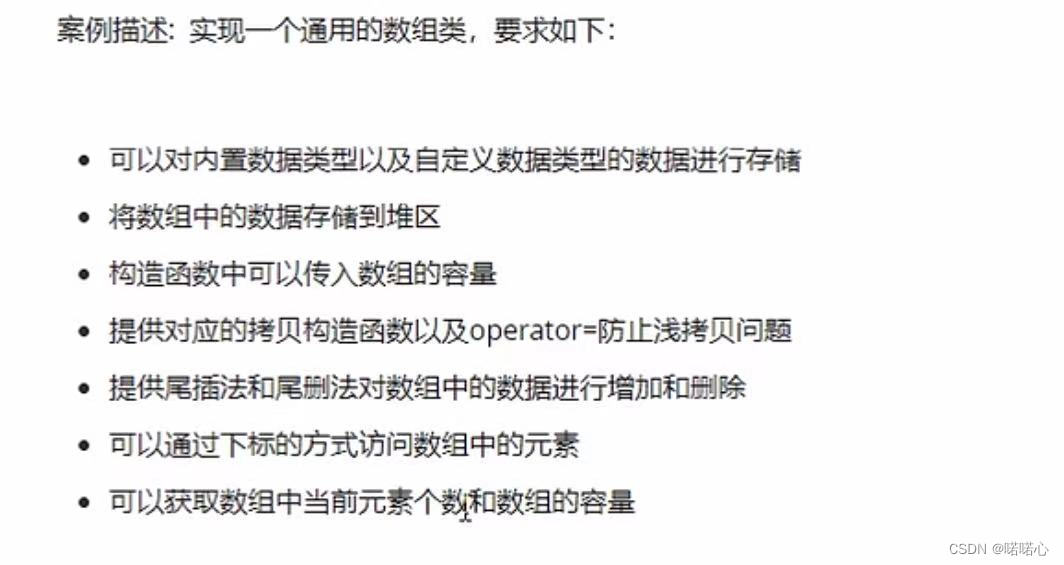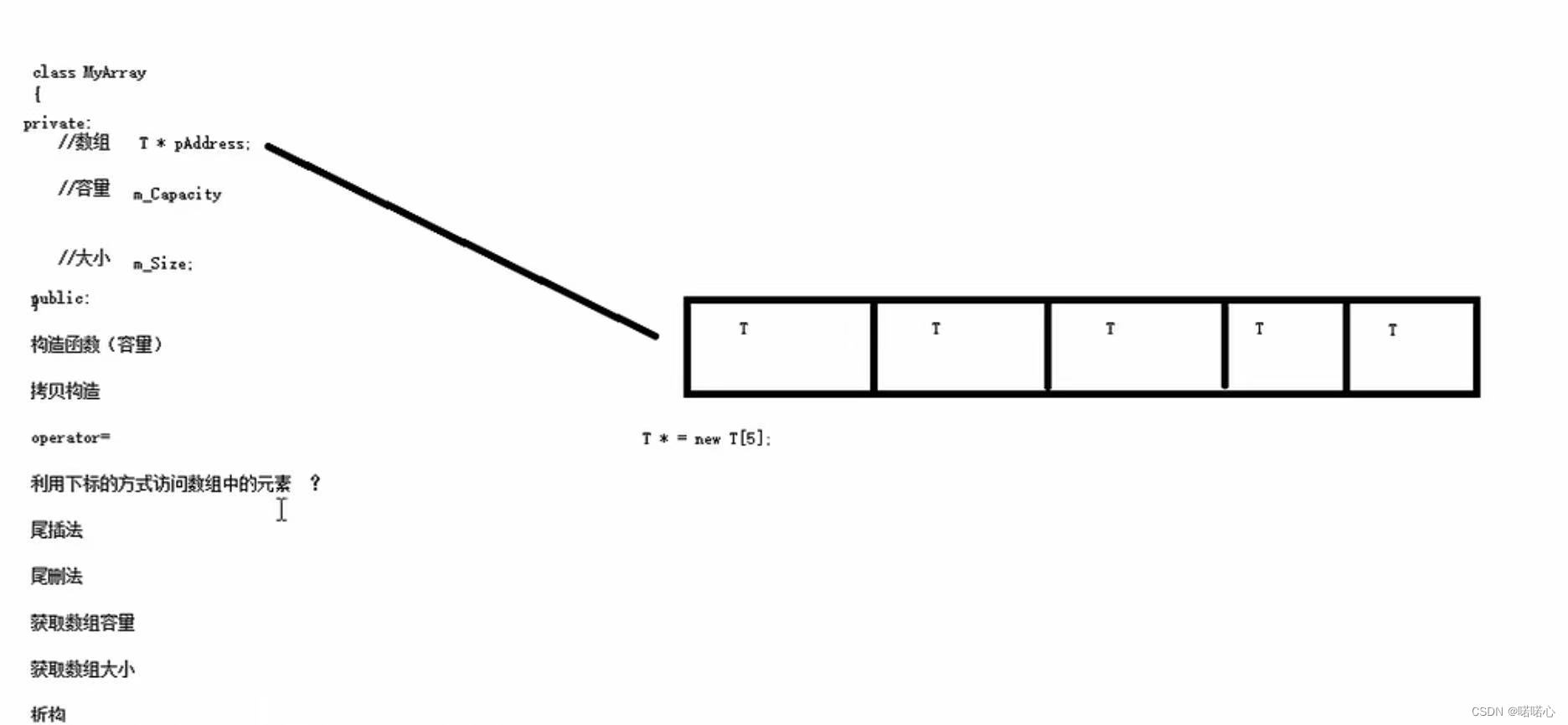目录
1、模板概念
2、模板特点
3、模板语法
3.1编程思想:泛型编程
3.2两种模板方法:
3.2.1 函数模板
3.2.2 类模板
1、模板概念
通用的模具,提高代码复用性
2、模板特点
不可以直接使用,只是一个框架;模板的通用性并不是万能的。
3、模板语法
3.1编程思想:泛型编程
3.2两种模板方法:
3.2.1 函数模板
函数模板的作用:建立一个通用函数,其函数返回值类型和参数类型可以不具体确定,用一个虚拟的类型来代表。
1)语法:
template<typename T>//函数声明或定义
函数
template——声明创建函数模板
typename——表明其后面的符号是一种类型,可以用class替代
T——通用的数据类型,名称可以替换,通常为大写字母
2)代码示例:
#include<iostream>
using namespace std;
//传统方法
//整型两个整型函数
void swapInt(int& a, int& b)
{
int temp = a;
a = b;
b = temp;
}
//交换两个浮点型
void swapDouble(double& a, double& b)
{
double temp = a;
a = b;
b = temp;
}
//函数模板
template<typename T>//声明一个模板,告诉编译器后面的代码中紧跟着的T不要报错,T是一个通用数据类型
void mySwap(T& a, T& b)
{
T temp = a;
a = b;
b = temp;
}
void test01()
{
int a = 10;
int b = 20;
swapInt(a, b);
cout << "a = " << a << endl;
cout << "b = " << b << endl;
double c = 30.33;
double d = 40.1;
swapDouble(c, d);
cout << "c = " << c << endl;
cout << "d = " << d << endl;
}
void test02()
{
int a = 10;
int b = 20;
//利用函数模板交换
//两种方式使用
//1、自动类型推到
mySwap(a, b);
//2、显示指定类型
mySwap<int>(a, b);//<>中指定T的类型
cout << "a = " << a << endl;
cout << "b = " << b << endl;
}
int main()
{
test02();
system("pause");
return 0;
}3)总结:
- 函数模板利用关键字Template
- 使用函数模板有两种方法:自动推导类型、显示指定类型
- 模板的目的是为了提高代码复用性,将类型参数化
4)注意事项:
- 自动类型推导,T必须推导出一致的数据类型
- 模板必须要确定出T的类型,才可以使用
5)案例-选择排序
#include<iostream>
using namespace std;
//实现通用的对数组进行排序的函数
//规则 从大到小
//算法 选择排序
//测试 char 数组、int数组
//交换模板
template<typename T>
void mySwap(T& a, T& b)
{
T temp;
temp = a;
a = b;
b = temp;
}
//排序模板
template<typename T>
void mySort(T arr[],int len)
{
for (int i = 0; i < len; i++)
{
int max = i;//认定最大值的下标
for (int j = i + 1; j < len; j++)
{
//认定的最大值 比 遍历的j下标要小,说明j下标的元素才是真的最大值
if (arr[max] < arr[j])
{
max = j;
}
}
if (max != i)
{
//交换这两个元素
mySwap(arr[i], arr[max]);
}
}
}
//打印数组的模板
template<typename T>//typename和class可相互替换
void printArray(T arr[],int len)
{
for (int i = 0; i < len; i++)
{
cout << arr[i] << " ";
}
cout << endl;
}
void test01()
{
char charArr[] = "badcfe";
int len = sizeof(charArr) / sizeof(char)-1;
mySort(charArr, len);
printArray(charArr, len);
}
void test02()
{
int intArr[] = { 1,4,3,6,3,8,2,10 };
int len = sizeof(intArr) / sizeof(int);
mySort(intArr, len);
printArray(intArr, len);
}
int main()
{
test01();
test02();
system("pause");
return 0;
}6)普通函数和函数模板的区别:普通函数可以发生隐式类型转换,但函数模板只有显示类型推导时,可以发生隐式类型转换
#include<iostream>
using namespace std;
//1、普通函数调用可以发生隐式类型转换
//2、函数模板 用自动类型推导,不可以发生隐式类型转换
//3、函数模板 用显示类型推导,可以发生隐式类型转换
//普通函数
int myAdd01(int a, int b)
{
return a + b;
}
template<typename T>
int myAdd02(T a, T b)
{
return a + b;
}
void test01()
{
int a = 10;
int b = 20;
char c = 'c';//把字符型变量转换为整型。ASCII,a-97,c-99,
cout << myAdd01(a, c) << endl;
//cout << myAdd02(a, c) << endl;//自动推导类型!错误示例
cout << myAdd02<int>(a, c) << endl;
}
int main()
{
test01();
system("pause");
return 0;
}7)普通函数和函数模板的调用规则:
结论:如果创建了函数模板,就别多此一举创建普通函数了,OK?
- 如果同时存在普通函数和模板函数,优先调用普通函数
- 函数模板也存在函数重载
- 可以使用空模板参数列表 强制调用 模板函数
- 如果调用模板函数可以产生更好的效果,优先调用模板函数
#include<iostream>
using namespace std;
//普通函数与函数模板调用规则
//1、如果普通函数和模板函数都可以调用,优先调用普通函数
//2、可以通过空模板参数列表 强制调用 函数模板
//3、函数模板可以发生函数重载
//4、如果函数模板可以产生更好的匹配,优先调用函数模板
void myPrint(int a, int b)
{
cout << "调用普通函数" << endl;
}
template<class T>
void myPrint(T &a, T &b)
{
cout << "调用模板" << endl;
}
template<class T>
void myPrint(T a, T b,T c)
{
cout << "调用 重载模板" << endl;
}
void test01()
{
int a = 10;
int b = 10;
//myPrint(a, b);
通过空模板的模板参数列表,强制调用函数模板
//myPrint<>(a, b);
函数模板也可以发生重载
//myPrint<>(a, b,100);
//如果函数模板产生更好的匹配,优先调用函数模板
char c1 = 'a';
char c2 = 'c';
myPrint(c1, c2);
}
int main()
{
test01();
system("pause");
return 0;
}8)模板的局限性

模板并不是万能的,有些特定的数据类型,需要具体化方式做特殊实现
#include<iostream>
using namespace std;
//模板的局限性
//模板并不是万能的,有些特殊数据类型,需要具体化方式做特殊实现
class Person
{
public:
Person(string name, int age)
{
this->m_Name = name;
this->m_Age = age;
}
string m_Name;
int m_Age;
};
//对比两个数据是否相等
template<class T>
bool myCompare(T& a, T& b)
{
if (a == b)
{
return true;
}
else
{
return false;
}
}
//利用具体化PersomyComparen的版本,具体化优先调用
template<>bool myCompare(Person& p1, Person& p2)
{
if (p1.m_Name==p2.m_Name && p1.m_Age == p2.m_Age)
{
return true;
}
else
{
return false;
}
}
void test01()
{
int a = 10;
int b = 20;
bool ret = myCompare(a, b);
if (ret)
{
cout << "a == b" << endl;
}
else
{
cout << "a != b" << endl;
}
}
void test02()
{
Person p1("Tom", 10);
Person p2("Tom",20);
bool ret = myCompare(p1, p2);
if (ret)
{
cout << "p1 == p2" << endl;
}
else
{
cout << "p1 != p2" << endl;
}
}
//
int main()
{
//test01();
test02();
system("pause");
return 0;
}3.2.2 类模板
建立一个通用类,类中成员 数据类型可以不具体制定,用一个虚拟的类型来代替
1)类模板语法
template <typename T>
类
template——声明创建模板
typename——表明其后面的符号是一种类型,可以用class替代
T——通用的数据类型,名称可以替换,通常为大写字母
#include<iostream>
using namespace std;
//模板类
template<class NameType,class AgeType>
class Person
{
public:
Person(NameType name, AgeType age)
{
this->m_Name = name;
this->m_Age = age;
}
void ShowPerson()
{
cout << "name: " << this->m_Name << " age: "<<this->m_Age << endl;
}
NameType m_Name;
AgeType m_Age;
};
void test01()
{
Person<string, int>p1("Susan", 99);//<string, int>模板参数列表
p1.ShowPerson();
}
int main()
{
test01();
system("pause");
return 0;
}2)类模板和函数模板的区别
- 类模板没有自动类型推导的使用方式
- 类模板在模板的参数列表中,可以有默认参数
#include<iostream>
using namespace std;
//模板类和函数模板的区别
//1、类模板没有自动类型推导的使用方式
//2、类模板在模板的参数列表中,可以有默认参数
//template<class NameType, class AgeType >//没默认参数
template<class NameType, class AgeType = int>//类模板可以有默认参数
class Person
{
public:
Person(NameType name, AgeType age)
{
this->m_name = name;
this->m_age = age;
}
void ShowPerson()
{
cout << "姓名:" << this->m_name << " 年龄:" << this->m_age << endl;
}
NameType m_name;
AgeType m_age;
};
void test01()
{
//Person p1("Susan", 18);//无法自动推导!错误示例
//无默认参数的调用
Person<string, int> p1("Susan", 18);//只能显示指定类型,正确示例
p1.ShowPerson();
}
void test02()
{
//有默认参数的调用
Person<string> p("Tom", 999);
p.ShowPerson();
}
int main()
{
test02();
system("pause");
return 0;
}3)类模板中成员函数的调用时机
- 普通类中的成员函数在一开始就可以创建
- 类模板中的成员函数在调用时才可以创建
#include<iostream>
using namespace std;
//类模板中的成员函数的创建时机
//普通类中的成员函数一开始就可以创建
//类模板中的成员函数在调用时才可以创建
class Person1
{
public:
void showPerson1()
{
cout << "Person1 show" << endl;
}
};
class Person2
{
public:
void showPerson2()
{
cout << "Person2 show" << endl;
}
};
template<class T>
class MyClass
{
public:
T obj;
//类模板中的成员函数,并不是一开始就创建,而是在模板调用时再生成
void func1()
{
obj.showPerson1();
}
void func2()
{
obj.showPerson2();
}
};
void test01()
{
MyClass<Person1>m;
m.func1();
//m.func2();//编译会出错,说明函数调用才会去创建成员函数
}
int main()
{
test01();
system("pause");
return 0;
}4)类模板对象做函数参数
类模板实例化出的对象,向函数传参的方式共三种:
- 指定传入的类型 --- 直接显示对象的数据类型
- 参数模板化 ---将对象的参数变为模板后进行传递
- 整个类模板化 ---将这个对象类型 模板化进行传递
#include<iostream>
#include<string>
using namespace std;
//类模板对象做函数参数
//1、指定传入的类型
//2、参数模板后
//3、整个类模板化
template<class T1,class T2>
class Person
{
public:
Person(T1 name, T2 age)
{
this->m_Name = name;
this->m_Age = age;
}
void showPerson()
{
cout << "姓名:" << this->m_Name << " 年龄:" << this->m_Age << endl;
}
T1 m_Name;
T2 m_Age;
};
//1、指定传入的类型
void printPerson(Person<string, int>&p)
{
p.showPerson();
}
void test01()
{
Person<string, int>p("Susan", 18);
printPerson(p);
}
//2、将参数模板化
template<class T1,class T2>
void printPerson2(Person<T1,T2>&p)
{
p.showPerson();
cout << "T1 的类型:" << typeid(T1).name() << endl;
cout << "T2的类型:" << typeid(T2).name() << endl;
}
void test02()
{
Person<string, int>p("Tom", 98);
printPerson2(p);
}
//3、整个类模板化
template<class T>
void printPerson3(T &p)
{
p.showPerson();
cout << "T的数据类型:" << typeid(T).name() << endl;
}
void test03()
{
Person<string, int>p("Lily", 20);
printPerson3(p);
}
int main()
{
test03();
system("pause");
return 0;
}总结:指定传入类型比较常用!
5)类模板与继承
- 当子类继承的是父类木板时,子类声明的时候,需要指定父类模板中T的类型
- 如果不指定,编译器无法给子类分配内存
- 如果想灵活指定父类中T的类型,子类也需要变为模板
#include<iostream>
#include<string>
using namespace std;
//类模板的成员函数的类外实现
template<class T1,class T2>
class Person
{
public:
Person(T1 name, T2 age);
void showPerson();
T1 m_Name;
T2 m_Age;
};
//构造函数的类外实现
template<class T1,class T2>
Person<T1,T2>::Person(T1 name, T2 age)
{
this->m_Name = name;
this->m_Age = age;
}
//成员函数的类外实现
template<class T1,class T2>
void Person<T1,T2>::showPerson()//!!!必须写模板参数列表!!!
{
cout << "姓名:" << this->m_Name << " 年龄:" << this->m_Age << endl;
}
void test01()
{
Person<string, int>p("Tom", 100);
p.showPerson();
}
int main()
{
test01();
system("pause");
return 0;
}注意:成员函数的类外实现
template<class T1,class T2>
void Person<T1,T2>::showPerson()//!!!必须写模板参数列表!!!
6)类模板分文件编写
类模板中的成员函数创建时机时在调用阶段,导致分文件编写时链接不上
- 解决方法1:直接包含.cpp文件
- 解决方法2:将声明和实现写到同一个文件中,并改后缀名为.hpp,hpp是约定的名称,并不强制
person1.hpp文件
#pragma once
#include<iostream>
using namespace std;
template<class T1, class T2>
class Person
{
public:
Person(T1 name, T2 age);
void showPerson();
T1 m_Name;
T2 m_Age;
};
template<class T1, class T2>
Person<T1, T2>::Person(T1 name, T2 age)
{
this->m_Name = name;
this->m_Age = age;
}
template<class T1, class T2>
void Person<T1, T2>::showPerson()
{
cout << "姓名:" << this->m_Name << " 年龄:" << this->m_Age << endl;
}13模板-类模板分文件编写.cpp
#include<iostream>
#include<string>
using namespace std;
//第一种解决方式
#include"person.cpp"//#include"person.h"改为#include"person.cpp"才不会报错
//第二种解决方式 将.h和.cpp文件中的内容写到一起,将后缀名改为.hpp文件
#include"person1.hpp"
//类模板的份文件编写
//类模板中的成员函数创建时机在调用阶段,导致分文件时链接不是
//
//template<class T1, class T2>
//class Person
//{
//public:
// Person(T1 name, T2 age);
//
// void showPerson();
//
// T1 m_Name;
// T2 m_Age;
//};
//template<class T1,class T2>
//Person<T1, T2>::Person(T1 name,T2 age)
//{
// this->m_Name = name;
// this->m_Age = age;
//}
//
//template<class T1, class T2>
//void Person<T1,T2>::showPerson()
//{
// cout << "姓名:" << this->m_Name << " 年龄:" << this->m_Age << endl;
//}
void test01()
{
Person<string, int>p("Susan", 19);
p.showPerson();
}
int main()
{
test01();
system("pause");
return 0;
}7)类模板和友元:建议使用全局函数的类内实现
#include<iostream>
#include<string>
using namespace std;
//类模板和友元
// 通过全局函数打印Person的信息
//提前让编译器知道Person类的存在
template<class T1,class T2>
class Person;
//全局函数 类外实现
template<class T1, class T2>
void printPerson2(Person<T1, T2> p)
{
cout << "类外实现——Name: " << p.m_Name << " Age:" << p.m_Age << endl;
}
template<class T1,class T2>
class Person
{
//全局函数 类内实现
friend void printPerson(Person<T1, T2> p)
{
cout << "Name: " << p.m_Name << " Age:" << p.m_Age << endl;
}
//全局函数 类外实现
//加空模板的参数列表
//如果成员函数类外实现,需要让编译器提前知道这个函数的存在
friend void printPerson2<>(Person<T1, T2> p);
public:
Person(T1 name,T2 age)
{
this->m_Name = name;
this->m_Age = age;
}
private:
T1 m_Name;
T2 m_Age;
};
//类内实现测试
void test01()
{
Person<string, int>p("Tom",10);
printPerson(p);
}
//类外实现测试
void test02()
{
Person<string, int>p("Susan", 2);
printPerson2(p);
}
int main()
{
//test01();
test02();
system(+"pause");
return 0;
}8)案例:通用的数组类
- 运用知识:类模板、深浅拷贝、函数重载

- 几个重点:
T* = new T[5];//new出来地址所以用地址变量承接,new的类型是T,所以指针数据类型也是T
”拷贝构造和operator=“防止在堆区数据浅拷贝带来的问题
T& operator[](int index)//函数调用作为左值,要反回引用&
- 代码实现:

#pragma once
//自己通用的数组类
#include<iostream>
using namespace std;
template<class T>
class MyArray
{
public:
//有参构造 参数 容量
MyArray(int capacity)
{
//cout << "MyArray 的有参构造调用" << endl;
this->m_Capacity = capacity;
this->m_Size = 0;
this->pAddress = new T[capacity];
}
MyArray(const MyArray& arr)//拷贝构造 防止浅拷贝问题
{
//cout << "MyArray 的拷贝构造调用" << endl;
this->m_Capacity = arr.m_Capacity;
this->m_Size = arr.m_Size;
//this->pAddress = arr.pAddress;//浅拷贝导致堆区开辟空间重复释放
//深拷贝
this->pAddress = new T[arr.m_Capacity];
//将arr中的数据拷贝过来了
for (int i = 0; i < this->m_Size; i++)
{
this->pAddress[i] = arr.pAddress[i];
}
}
//operater= 防止浅拷贝问题
MyArray& operator=(const MyArray& arr)
{
//cout << "MyArray 的operater=调用" << endl;
//先判断原来堆区是否有数据,有就先释放
if (this->pAddress != NULL)
{
delete[] this->pAddress;
this->pAddress = NULL;
this->m_Size = 0;
this->m_Capacity = 0;
}
//深拷贝
this->m_Capacity = arr.m_Capacity;
this->m_Size = arr.m_Size;
this->pAddress = new T[arr.m_Capacity];
for (int i = 0; i < arr.m_Capacity; i++)
{
this->pAddress[i] = arr.pAddress[i];
}
return* this;
}
//尾增
void Push_Back(const T& val)
{
//判断容量是否等于大小
if (this->m_Capacity == this->m_Size)
{
return;
}
this->pAddress[this->m_Size] = val;//数组末尾插入数据
this->m_Size++;//更新数组大小
}
//尾删
void Pop_Back()
{
//让用户访问不到最后一个元素,即为尾删,逻辑删除
if (this->m_Size == 0)
{
return;
}
this->m_Size--;
}
//用户通过下标访问数组中元素 arr[0]=100;
T& operator[](int index)//函数调用作为左值,要反回引用&
{
return this->pAddress[index];
}
//返回数组容量
int getCapacity()
{
return this->m_Capacity;
}
//返回数组大小
int getSize()
{
return this->m_Size;
}
//析构函数 堆区数据清空
~MyArray()
{
//cout << "MyArray 的析构函数调用" << endl;
if (this->pAddress != NULL)
{
delete[] this->pAddress;
this->pAddress = NULL;//指针置为空
}
}
private:
T* pAddress;//指针指向堆区开辟的真实数组
int m_Capacity;//数组容量
int m_Size;
};